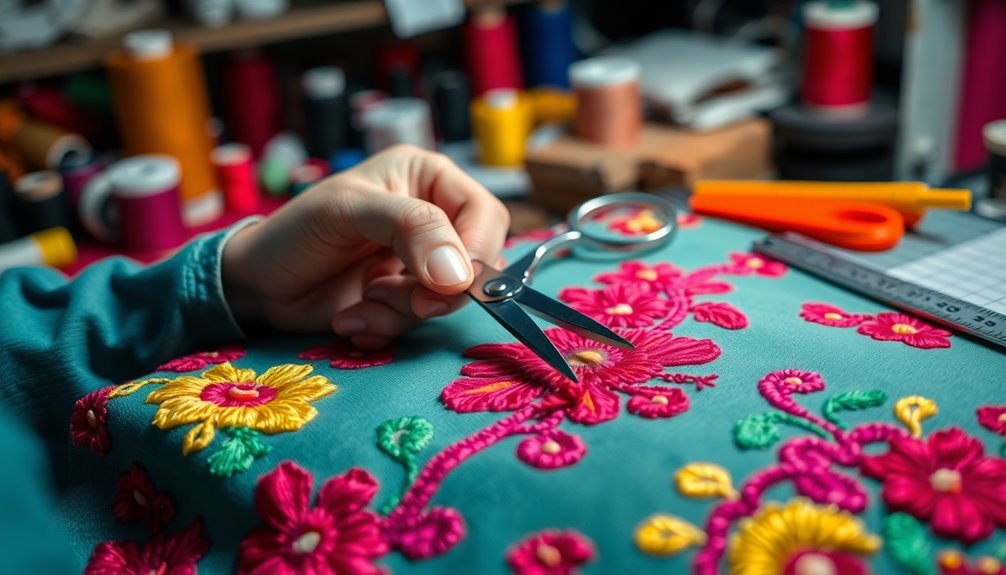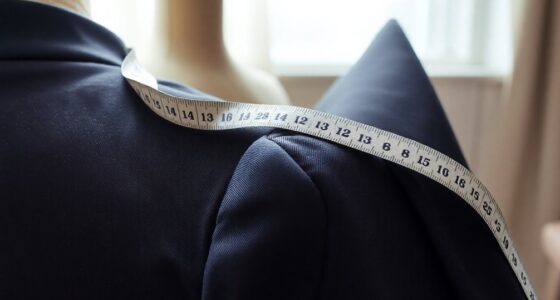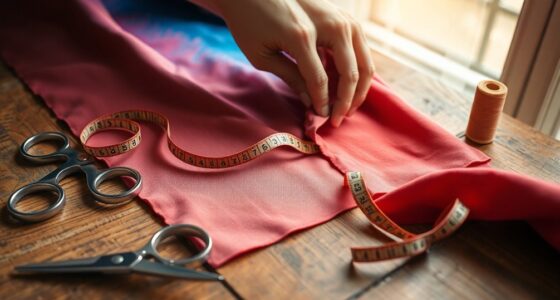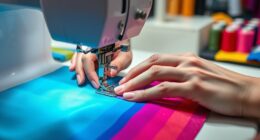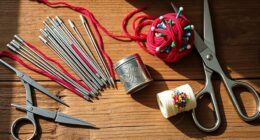Yes, a tailor can remove embroidery from your garments using specialized tools like seam rippers and embroidery scissors. They'll assess the fabric type and carefully pick apart the threads, sometimes using steam or heat to help loosen them. While it's possible to restore your clothing's original look, there are limitations, and some fabrics may get damaged. If you're curious about the process or need tips on when a professional is necessary, there's more to explore.
Key Takeaways
- Yes, a skilled tailor can remove embroidery using specialized tools like seam rippers and embroidery scissors.
- The process may involve applying steam or heat to loosen threads for easier removal.
- Different fabric types affect the ease of removal; delicate fabrics require extra care to prevent damage.
- Minor thread holes or marks may remain post-removal, especially on darker or tightly woven materials.
- Consulting a tailor beforehand helps set realistic expectations and understand any limitations involved in the removal process.
Understanding the Tailoring Process for Embroidery Removal
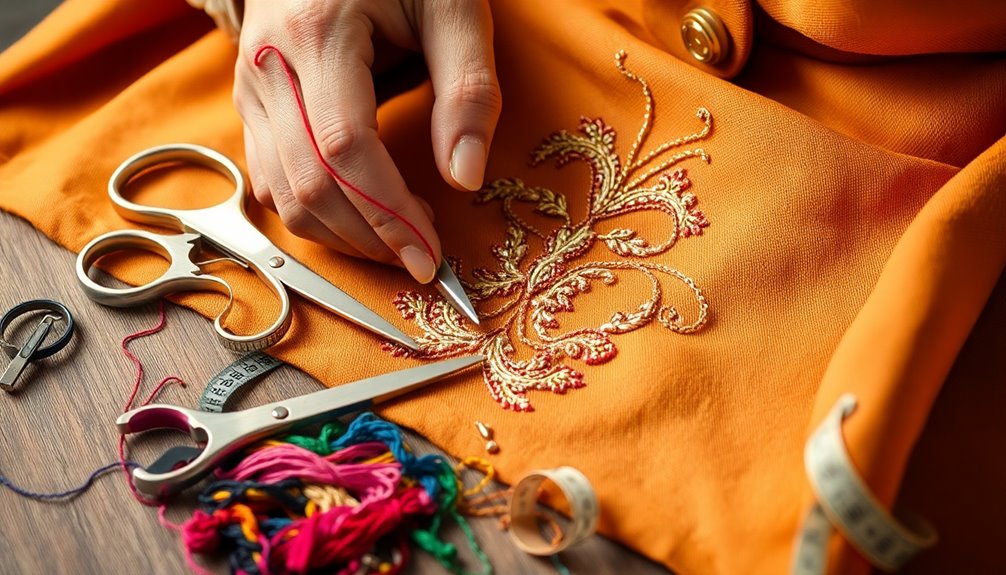
When you consider having embroidery removed from a garment, it's important to understand the tailoring process involved. A skilled tailor uses tools like a seam ripper or embroidery scissors, emphasizing attention to detail to avoid damaging the fabric.
The process often starts with loosening the threads using steam or heat, making it easier to extract the embroidery without harming the garment underneath. However, keep in mind that some fabrics, like leather, pose challenges, and removal mightn't be feasible.
Communicating your expectations with the tailor is essential, as the complexity of the embroidery and fabric type can affect the outcome. Consulting with a tailor beforehand can provide valuable insights into the process and its limitations.
Tools a Tailor Uses for Removing Embroidery
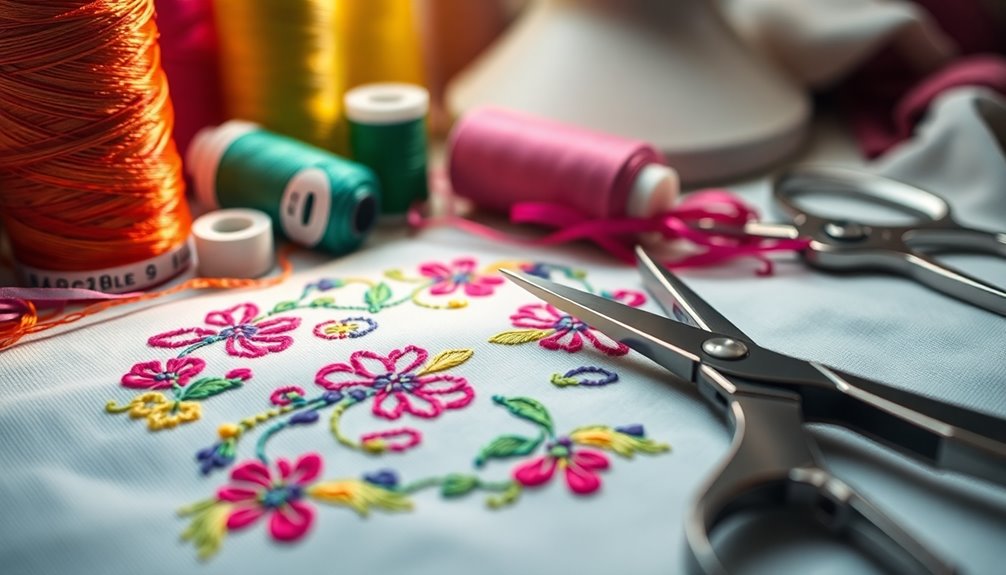
To effectively remove embroidery, a tailor relies on specific tools designed for precision and care. A seam ripper is essential, with its pointed end for picking apart stitches and a curved blade for lifting threads without damaging the fabric.
Embroidery scissors, featuring a precise tip, allow you to snip threads in tight areas. Tweezers can help grasp and pull out stubborn threads that are hard to reach.
Sometimes, using a heat tool or steam loosens the threads, making removal smoother. Don't forget fabric markers or dyes to camouflage any thread remnants, ensuring a clean finish.
Just like your grandmother's sewing techniques, take your time with these tools to achieve the best results.
Step-by-Step Guide to Professional Embroidery Removal
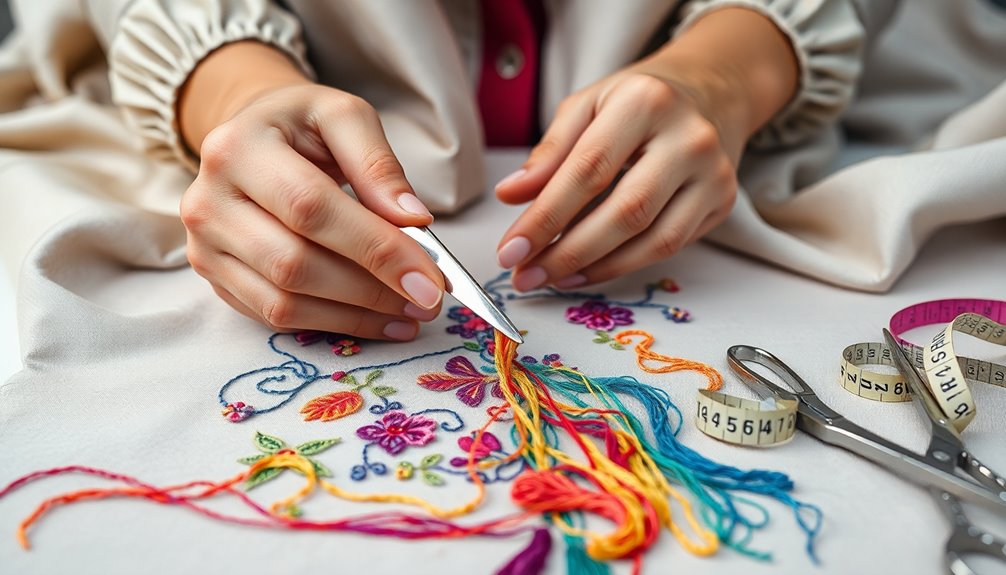
Removing embroidery can seem challenging, but with the right approach, it's quite manageable.
Start by gathering your tools, like a seam ripper and embroidery scissors. Begin on the back of the fabric, gently picking at the threads with your seam ripper. Take your time; you want to avoid disturbing the underlying material.
If the threads feel tight, apply steam or heat cautiously to loosen them. After removing stitches from one side, flip the fabric and repeat the process until the embroidery is gone.
If you encounter intricate designs or delicate fabrics, don't hesitate to seek professional help. A skilled tailor knows how to handle different fabrics and will guarantee minimal damage to your garment.
Considerations for Different Fabric Types
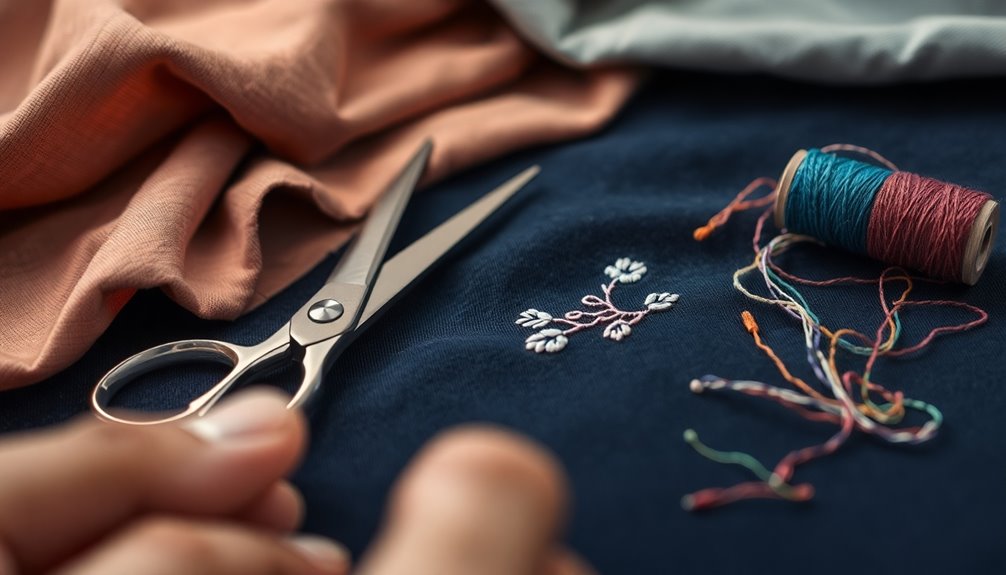
While considering embroidery removal, the type of fabric plays an essential role in determining how easily you can proceed.
Fibrous materials like cotton and linen allow easier thread removal, but they might show stitch marks afterward. In contrast, tightly woven or delicate fabrics require extra care, as they can tear easily. Non-fibrous materials like leather are less flexible, making damage more likely.
Before you start, evaluate the fabric's integrity; some materials won't revert to their original state post-removal. Choosing the right tool is important, too.
- Use a seam ripper for sturdy fabrics.
- Opt for embroidery scissors on delicate materials.
- Test a small area first.
- Always work slowly to avoid mistakes. Additionally, understanding the risk tolerance of the fabric can help decide the best approach for removal.
When to Seek Professional Tailoring Services
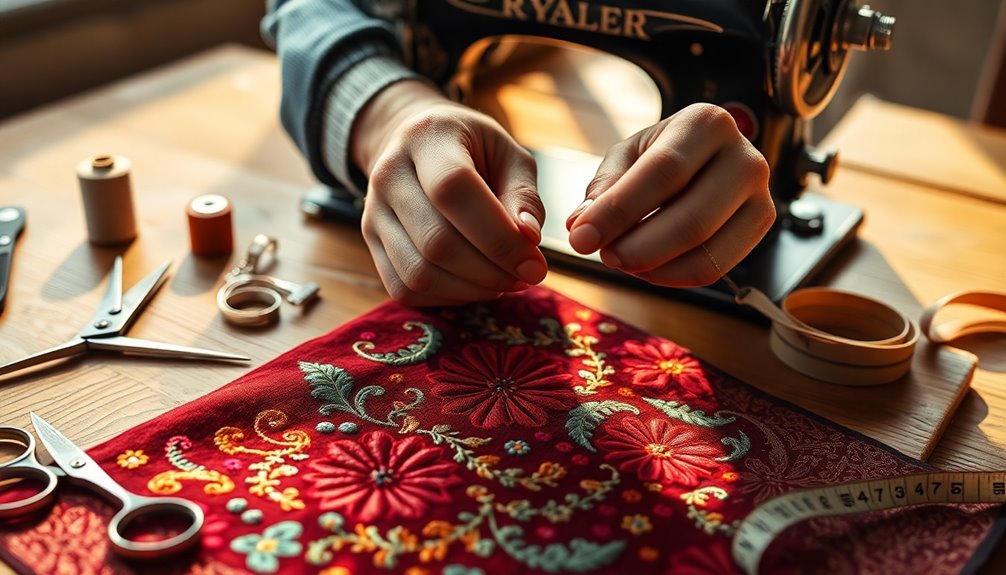
If you've got complex embroidery that needs removal, it's best to turn to a professional tailor.
They've the right tools and expertise to preserve your fabric's integrity and avoid any damage.
Consulting with a tailor can also help you understand the process and what to expect.
Complex Embroidery Removal Cases
When dealing with complex embroidery removal, it's crucial to recognize when to seek professional tailoring services. If your garment features delicate fabrics or intricate designs, a tailor's expertise can prevent damage.
Here are some signs it's time to call in a pro:
- The embroidery is integrated into seams or hems.
- You're working with fabrics like silk or linen that can show stitch marks.
- The embroidery is extensive and could affect the garment's fit.
- You need alterations after removal to maintain style and shape.
Professional tailors use specialized tools and techniques to guarantee a clean removal, minimizing any residual marks. Additionally, just as with renewable energy sources, trusting professionals can yield better results in the long run.
Don't risk a DIY disaster—trust the experts to handle your complex embroidery cases.
Preservation of Fabric Integrity
Removing embroidery can be tricky, especially if you want to keep the fabric intact. Professional tailors specialize in this delicate process, equipped with the right tools and expertise to minimize damage.
If you're dealing with fabrics like silk or linen, it's wise to seek help, as they can easily show stitch marks or holes post-removal. A tailor can assess your garment's structure, ensuring they choose the best technique that maintains the fit and design.
If your piece has sentimental value or features complex embroidery, their careful handling will be invaluable. Additionally, they can suggest alternatives like patching or reworking the embroidery into a new design, preserving your garment's aesthetic while addressing your needs. Furthermore, understanding the potential state tax implications of any alterations might save you money in the long run.
Benefits of Removing Embroidery From Garments
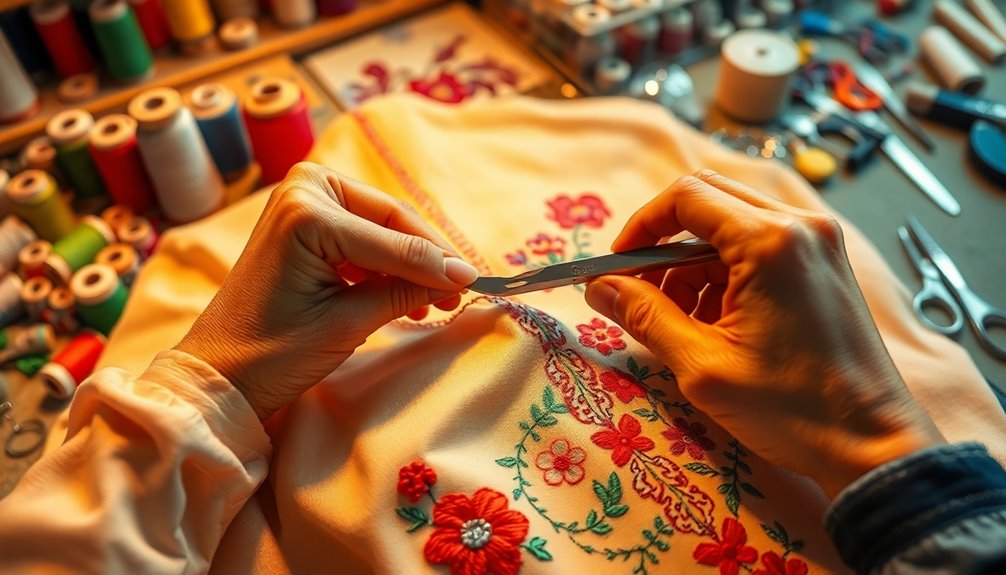
Removing embroidery from your garments can greatly enhance their market appeal, making them more attractive for resale or donation.
It also opens up personalization options, allowing you to modify the clothing to better fit your style.
Enhances Market Appeal
While many garments come adorned with embroidery, eliminating these embellishments can greatly boost their market appeal.
By removing embroidery, you transform the item into a blank canvas, attracting a wider audience. Garments without logos are often more desirable for resale, fitting minimalist trends and integrating easily into various wardrobes.
Consider these benefits of removing embroidery:
- Broader audience: Eliminate brand associations to attract more potential buyers.
- Enhanced versatility: A polished look makes the garment suitable for different occasions.
- Increased resale value: Minimalist designs are often more sought after.
- Potential for new designs: With the fabric intact, you can easily personalize or repurpose the garment.
Additionally, embracing a minimalist style can contribute to sustainable practices, allowing consumers to make more environmentally conscious fashion choices.
Embrace the possibilities of a fresh start!
Facilitates Personalization Options
By transforming a garment into a blank canvas, you open up exciting avenues for personalization. Removing embroidery not only allows you to ditch outdated logos but also gives you the freedom to express your unique style.
With a professional tailor's help, you can guarantee the removal process minimizes any damage to the fabric, preserving its quality. Once the embroidery is gone, you can get creative—add new designs, patches, or embellishments that resonate with your current tastes.
This customization opportunity lets you incorporate personal messages or fresh branding that truly reflects who you are. Embracing this transformation can make your wardrobe feel more personal, guaranteeing your clothes are as distinctive as you are. Additionally, personalizing garments can enhance your overall style while allowing you to express your unique aesthetic choices.
Improves Resale Value
When you eliminate embroidery from your garments, you not only update their look but also considerably boost their resale value.
Removing visible branding appeals to a wider audience, attracting buyers who prefer clean, versatile pieces. This customization can make your items stand out on resale platforms, often leading to higher demand and pricing.
- Unbranded items are easier to pair with various outfits.
- Buyers love envisioning their unique designs on a fresh canvas.
- A tailored garment signals quality and care, enhancing desirability.
- Clean pieces often sell faster, as they attract a broader market.
Additionally, embracing continuous learning in fashion choices can further enhance your personal style and marketability.
Common Limitations in Embroidery Removal
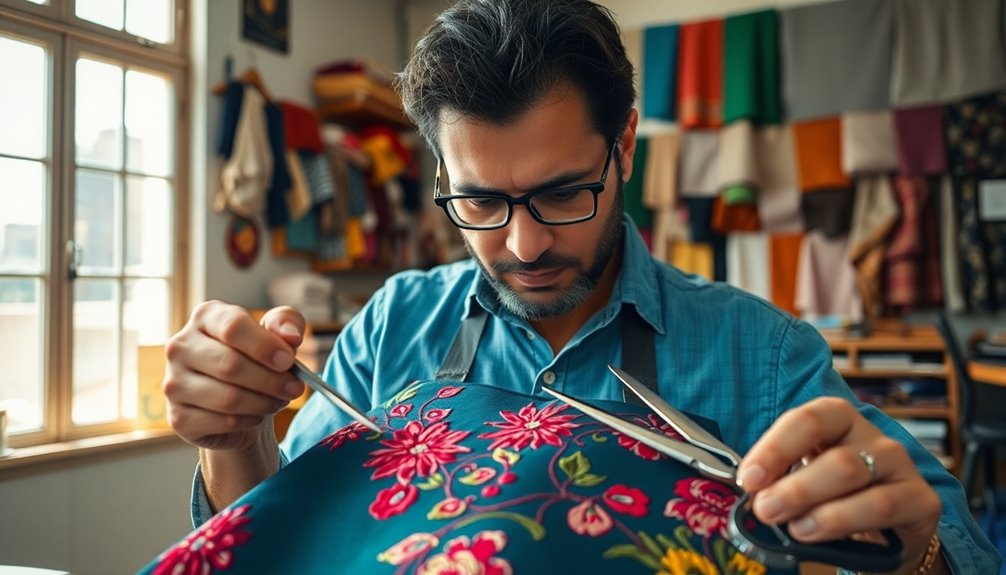
Removing embroidery can be a delicate process that presents several limitations, especially depending on the fabric type.
Tailors often use specialized tools like seam rippers or embroidery scissors, but careful technique is essential to avoid damaging the fabric. If you have delicate fabrics like silk or linen, there's a risk of leaving visible holes or marks.
Additionally, heavy or intricate embroidery mightn't be completely removable without affecting the garment's overall appearance. Even after removal, minor thread holes may remain, particularly noticeable on darker fabrics.
Some tailors may advise against removal if it compromises the garment's integrity, especially if the fabric lacks sufficient seam allowance or structure for alterations.
Always consult your tailor for the best option.
Transforming Your Wardrobe With Tailored Alterations
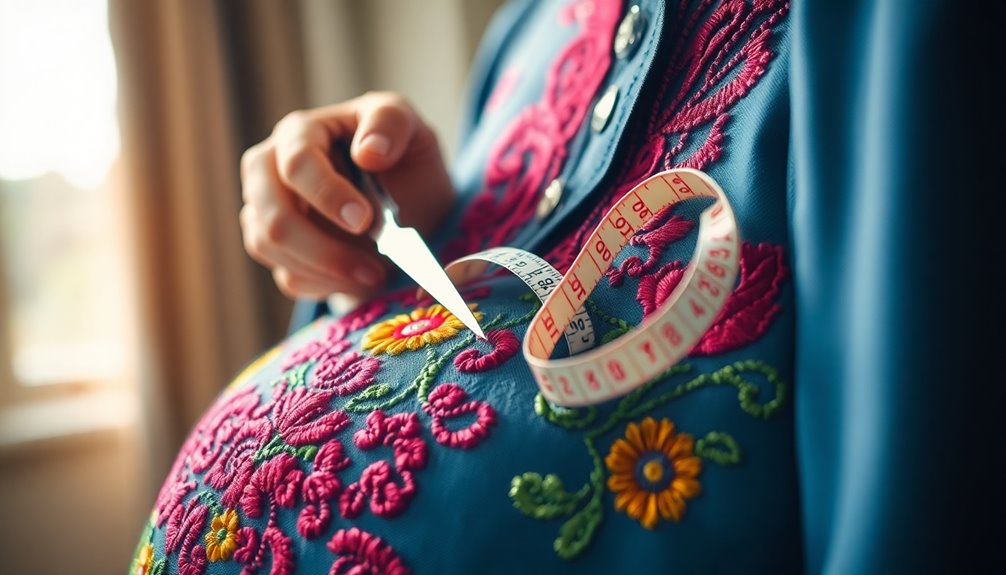
Tailored alterations can breathe new life into your wardrobe, allowing you to transform outdated or ill-fitting pieces into stylish, personalized garments.
By working with a skilled tailor, you can remove unwanted embroidery and create versatile clothing that aligns with your current style.
Here are some benefits of tailored alterations:
- Refresh your look: Turn old favorites into trendy staples.
- Enhance fit: Guarantee your clothes fit perfectly, boosting your confidence.
- Expand usability: Make garments suitable for donation or resale without visible branding.
- Personalize styles: Customize pieces to reflect your unique fashion sense.
With tailored alterations, you not only revitalize your wardrobe but also guarantee it's filled with items you truly love wearing. Additionally, investing in personalized outfits can contribute to long-term financial planning for your clothing budget, ensuring that you make the most of your wardrobe choices.
Frequently Asked Questions
Will a Tailor Remove Embroidery?
Yes, a tailor can remove embroidery from your garment. They typically use specialized tools like seam rippers to guarantee the fabric remains intact.
However, keep in mind that some fabrics are more delicate and may sustain damage during the process. You should consult with your tailor beforehand to discuss the feasibility and potential for minor marks or holes remaining after removal. Additionally, it’s important to consider the type of super glue application on fabric that may have been used, as some adhesives can be more difficult to remove than others. If your garment is particularly valuable or sentimental, seeking professional help is always advisable to minimize any risk of harm. Ultimately, a tailored approach ensures that your fabric receives the careful treatment it deserves during the removal process.
Professional help often yields better results than a DIY attempt.
Is It Possible to Unembroider Something?
Did you know that around 25% of people have had to remove embroidery from their clothing at some point?
Yes, you can unembroider something. Using tools like a seam ripper or embroidery scissors, you can carefully remove stitches. It takes patience and precision to avoid damaging the fabric.
Applying steam can help loosen threads, making removal easier. If you're unsure, consider seeking professional help to maintain your garment's integrity.
Will Removing Embroidery Leave Holes?
Removing embroidery can leave holes in your fabric, but it largely depends on the material.
If you're working with delicate woven fabrics, you might notice more significant holes compared to knits. Thick materials like denim typically show minimal damage.
To minimize this risk, use a seam ripper carefully and take your time. Some fabrics can even self-repair over time, making any small holes less noticeable.
Always consider the fabric type before starting.
Can Dry Cleaners Remove Logos?
Dry cleaners typically can't remove logos, as that process requires specialized techniques beyond standard cleaning.
They focus on maintaining and cleaning garments, not altering them. If you want a logo removed, it's best to consult a tailor or seamstress who's experienced with embroidery.
Some dry cleaners might offer spot cleaning or patching, but results can vary. Always check with your cleaner to understand their specific capabilities regarding logo and embroidery removal.
Conclusion
In summary, removing embroidery can breathe new life into your wardrobe, allowing you to enjoy your garments in fresh ways. Did you know that nearly 60% of people have garments they don't wear because of outdated embroidery? By seeking professional tailoring services, you can transform those pieces and make them fashionable again. Embrace the change and consider how a little alteration can release a whole new style for you!
